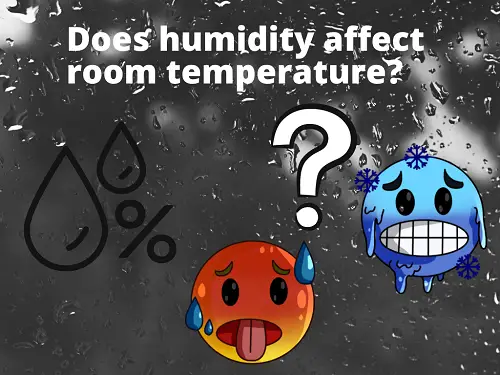The relative humidity of the air in the room does not directly affect room temperature. It does, however, affect the way we perceive temperature. Relative humidity levels between 30 and 70 % do not affect our perception of temperature much. Humidity levels below 30% or above 70% reduce our thermal comfort.

Humidity plays a large role in our perception of temperature. It determines whether the weatherman says the temperature feels hotter or colder than it really is. Indoors, temperature combined with relative humidity determines our thermal comfort. Outdoors, the wind is an additional factor influencing our thermal comfort.
The official term for humidity is relative humidity, which can be measured with a hygrometer.
What is humidity exactly?
The air contains a certain amount of moisture in the form of water vapor. This is what we call humidity. This water is not visible to our eyes. However, we notice it when it condenses on a surface or when the air becomes foggy.
Humidity levels are normally expressed in terms of relative humidity (RH).
In my newly bought old home, I often struggle with getting the temperature and humidity optimal. In the Netherlands, our winters are very humid. The following picture shows our room temperature and relative humidity in our yet poorly insulated and poorly heated home (early 2021).

What is relative humidity?
Relative humidity (RH) is the term used to describe how humid or how dry the air is. It is always stated as a percentage. This percentage shows how much water vapor is in the air relative to how much water vapor the air can hold in total. For example, when the relative humidity is 50%, the air contains half of the total amount of water it can contain.
The amount of water the air can contain depends on the temperature of the air. Warmer air can contain more water vapor and cold air can contain less.
Warm air can contain more water than cold air
For example, when 100 cubic feet of air at 70 F (21 C) contains 100% of the water it can hold (100% relative humidity), it contains 0.08 lbs (0.036 kg) of water. At 50% relative humidity, it would contain half of that, 0.04 lbs (0.0175 kg).
If the temperature drops, the amount of water the air can contain is reduced. Therefore, the relative humidity will increase. The amount of water that was indicated by 50% RH could now be, for example, 60% of the maximum amount the air can contain. Therefore, the same amount of water is now shown as 60% relative humidity.
When the temperature of the air at full saturation (100% RH) would drop, it would not be able to hold all this water anymore. Part of this water vapor will now become liquid water. It might condense on a surface such as a window, or the air might become foggy.

Photo by Duy Thanh Nguyen on Unsplash
Since windows are usually colder than the indoor air, air that comes into contact with the window will cool down. When the relative humidity is very high, or the window is especially cold, the air can’t hold all of its water vapor anymore. Therefore, some of it becomes liquid water and is visible as condensation on the window.
Why does relative humidity affect our perception of room temperature?
So, why does the amount of water in the air affect how comfortable we feel? Well, our experience of thermal comfort is based on our ability to regulate our body temperature.
Our internal temperature needs to be around 98 F (37 C) all the time. When we are too hot, our body tries to cool us down via sweating. Sweat is simply water (with some salt) that evaporates from our bodies into the air. This helps us lose heat because sweat takes some of our heat and gives it to the air.
However, when the air is already full of water vapor (high RH), it is harder to evaporate sweat. Therefore, it is harder for us to lose our excess warmth. Because of this, we experience the air as hotter than it actually is. Therefore, we experience less thermal comfort in hot, humid air.
In hot air, we can tolerate relatively dry air.
In cold air, we can tolerate relatively humid air.
What level of relative humidity is the most comfortable?
When the relative humidity is between 30 and 70 % it does not affect our thermal comfort all too much. However, RH is considered optimal between 35 and 55%.
The ASHRAE (American Society of Heating, Refrigerating and Air-Conditioning Engineers) recommends keeping the relative humidity below 60%. They have no recommendation for a lower limit of RH. However, low relative humidity (30% or less) can cause us to feel less comfortable.
The following chart shows in which temperature + humidity combination we feel comfortable. On the extreme ends, for example, with high humidity and high temperature, we feel uncomfortable.

Conclusion: does humidity affect room temperature?
Now that we know everything about humidity and its impact on how we perceive temperature, we know that:
- Humidity does not affect room temperature directly, however,
- it affects how we perceive the temperature in the room
- As long as the RH is between 40% and 70%, humidity won’t drastically influence the perceived room temperature
- Optimal relative humidity levels are between 35% and 55% RH
A dehumidifier can help reduce the relative humidity in your home. I wrote a series of articles on dehumidifiers. If you want to know more, I recommend starting with my article about the pros and cons of dehumidifiers:

